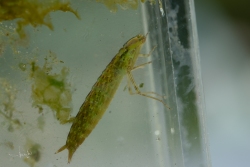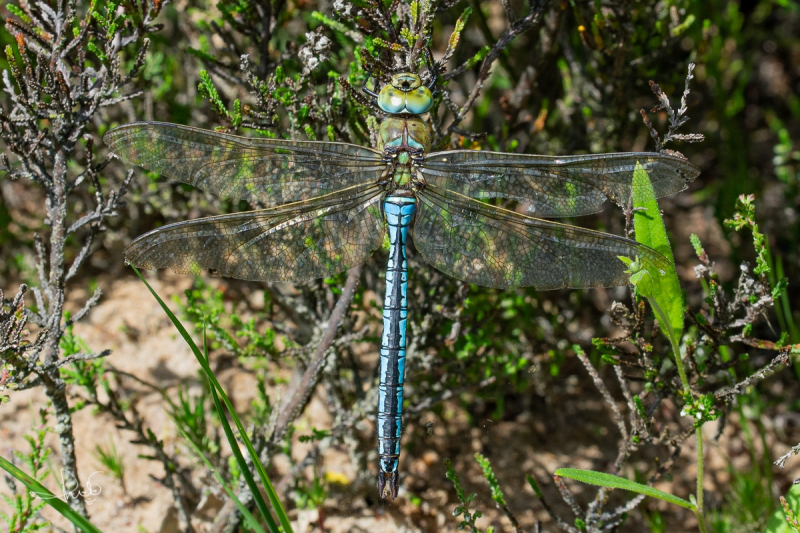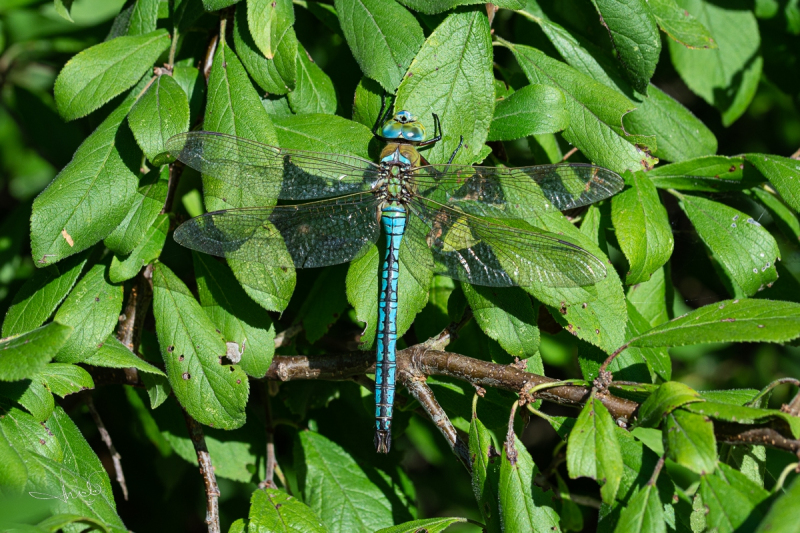A few years ago we dug a large pond in our garden. The first year it was already full of blue-tailed damselflies (Ischnura elegans) and broad-bodied chasers (Libellula depressa), followed by four-spotted chasers (Libellula quadrimaculata), azure damselflies (Coenagrion puella), large red damselflies (Pyrrhosoma nymphula) and more species.
Common species
Until 1950, the emperor dragonfly was not a common species in the Netherlands at all but it can now be found everywhere. The species is not that picky and often occurs in larger puddles or ponds, but also in smaller puddles, fens, (flowing) ditches and canals. The dragonfly appears to have a preference for water that warms up relatively quickly but that is also rich in nutrients. In that water, the female deposits her eggs on or near floating aquatic plants.
Hunter
The emperor dragonfly has a large thorax that is almost uniformly green in colour. The tail of the males is sky blue with a black longitudinal stripe, while the tail of the females is green. Its eyes are green in colour, sometimes with some brown. But as is often the case with faceted eyes, the colour also depends on the light, although the green colour will predominate. The emperor dragonflies, like other dragonfly species, are real hunters. They make long hunting flights, often in sheltered places such as along a forest edge. The prey consists of all kinds of flying insects, such as butterflies but also other (smaller) dragonflies and damselflies. The prey is caught and consumed in flight.
Transfiguration
Just like with butterflies and moths, dragonflies and damselflies go through a long process after the egg stage before we can see the beautiful insects flying. Adult insects are called an imago, plural imagines or imagoes. In butterflies and moths there is a caterpillar stage and then the pupa, in dragonflies there’s a larval or nymph stage and no pupa. There is a difference between the butterfly caterpillar and the dragonfly nymphs. In butterflies there is a so-called complete metamorphosis. The caterpillar does not resemble the adult animal in any way, and only in the pupal phase the caterpillar changes into a butterfly or moth. In dragonflies and damselflies, the nymph already has some characteristics of the adult animal and with each moult it also looks more like an imago. During the final moult the dragonfly or damselfly as we know it emerges.
Overwintering
Many dragonflies hibernate once or twice. There are exceptions, such as the nymph of the aforementioned golden-ringed dragonfly, which takes a lot longer. This hibernates three to four times, but sometimes even five times. On the other hand, there are also species whose nymphs do not hibernate at all, but grow into an imago in the same year, such as with the common winter damselfly (Sympecma fusca) and the Siberian winter damsel (S. paedisca). They live about nine months, so that they can hibernate as an imago and mate and lay eggs in spring. Most damsels and dragonflies spend one to several years as a nymph, but live only one to two months as an imago. So dragonflies and damselflies spend most of their lives underwater. Depending on the species, they moult nine (for damselflies) to sixteen times (for dragonflies). The more they have to eat, the faster they literally burst out of their skin and therefore have to moult.
Two ‘generations’
If the nymph of the emperor dragonfly has sufficient food after the first hibernation, it will be gorged during the spring to such an extent that it is almost fully grown at the beginning of the summer. They may moult once or twice more and from June to the end of August these dragonflies emerge. Others, who may have less food available, continue to eat all year round up to and including the penultimate moult. They then enter winter as fully grown nymphs and fledge from May the following year. The emperor dragonflies that you see flying in May are all individuals that have spent two winters as nymphs. So it seems as if there are two generations per year, although that is of course not true. After all, the late flyers are not descendants of the early flyers.
Hinged labium
Dragonfly nymphs, just like the adults, are also real hunters. Their food consists of all kinds of other animals. Everything smaller than themselves is eaten, including small fish, young frogs and salamanders. But also nymphs of other dragonflies and damselflies. And they can be cannibalistic too, nymphs of their own species are eaten without mercy. They hunt in a special way. They very carefully sneak up on their unsuspecting prey and when they are close enough they catch it with their so-called hinged labium (a toothed mouthpart similar to a lower mandible, which is sometimes termed as a “mask” as it is normally folded and held before the face). Compare this with a lower jaw with two grippers attached to it. This labium can extend forward and retract rapidly to capture prey. Just as quickly as the labium snaps forward, it snaps back and the nymph begins to feast on the catch. The video below, which Annette van Berkel of the Dutch Butterfly Conservation made from the nymph of a southern hawker (Aeshna cyanea), clearly shows how quickly the prey is captured.
Nymphs in all shapes and sizes
Because of all those egg-laying dragonflies and damselflies, our pond is filled with nymphs, in all shapes and sizes. Thin, elongated nymphs of damselflies, which can be recognised, among other things, by the three protrusions at the end of their tail. And thick nymphs of dragonflies, where those of the emperor dragonfly clearly stand out. This one has already moulted a number of times and has grown quite large. By the way, the nymph can grow to almost six centimeters in length.
Sources:
- Vlinderstichting (in Dutch)
- Wikipedia













This year is our first with a pond, so I loved reading this post and learned a lot! Very nice photos too.
It has amazed me how fast life moved in, and it is endlessly fascinating just to sit and watch. To my delight many different several different dragonflies and damselflies have come to lay eggs, even the emperor 🙂
Thanks Camilla! I’m curious to see what will fly around your pond next year.